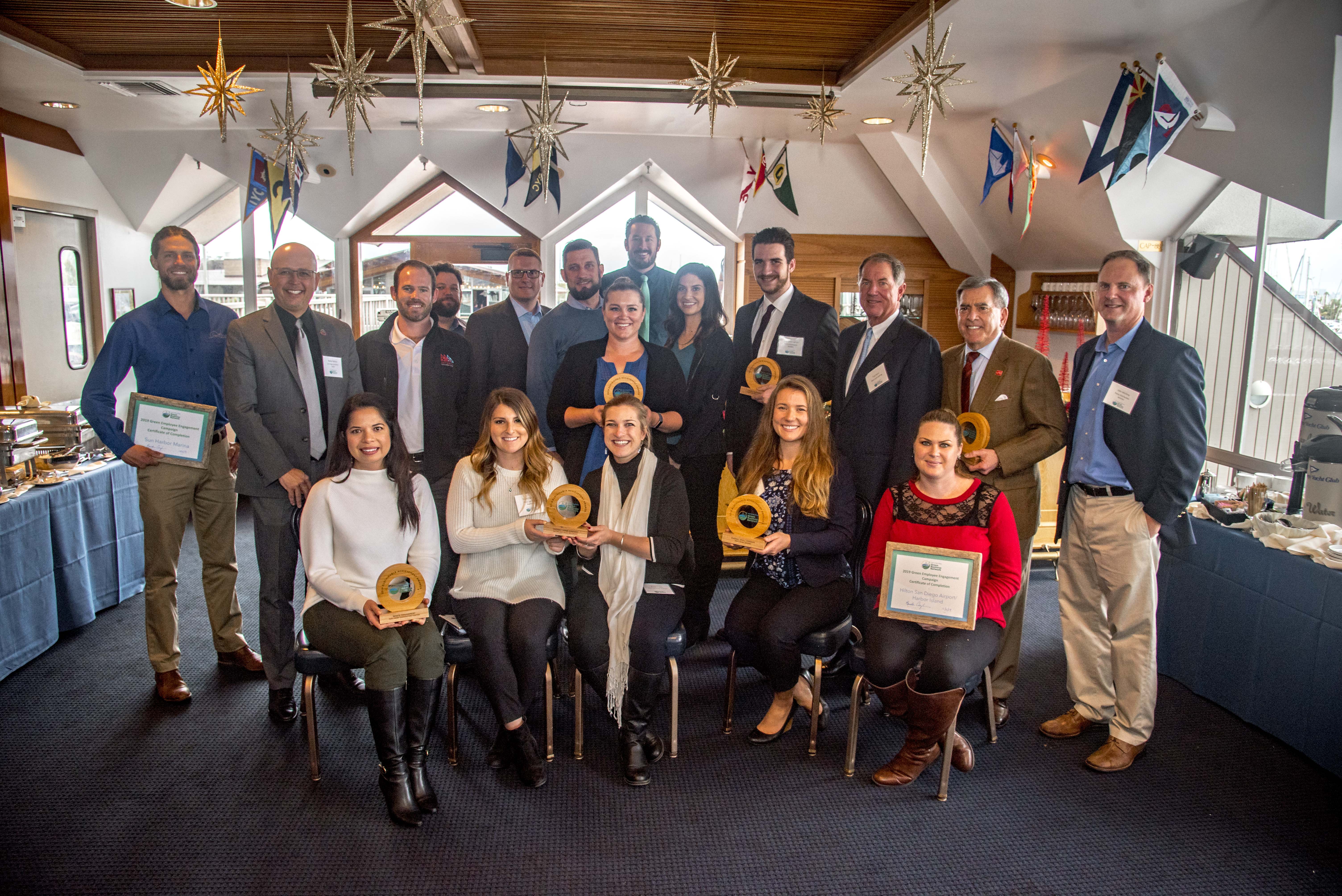Port of San Diego
The Port of San Diego’s (Port’s) Green Business Network (Network) is an integrated energy efficiency and sustainability program that educates tenant businesses on sustainable business practices and identifies resources to implement building and operational improvements. The Green Business Network provides a forum for businesses across the Port’s five member cities to network on sustainability best practices. Between 2010 and 2017, participating businesses reduced energy use by 10.8 million kWh and 300,000 therms.
Background
Note: To minimize site maintenance costs, all case studies on this site are written in the past tense. When the program is ongoing as is the case with this particular program, the Introduction (only) is written in the present tense.
While many ports in California were focused predominantly on the cargo industry, the Port was unique, with most land comprised of commercial tenants (including hotels, museums, restaurants, retail stores, and a convention center), industrial businesses, two maritime terminals and two cruise ship terminals. For this reason, the Green Business Network was instrumental in educating and engaging a diverse group of businesses on the importance of sustainability and how businesses could leverage existing utility programs to reduce project costs and increase return on investment.
The Network included over 80 businesses across all business sectors of the Port which benefited from the resource offerings. These resources included educational and technical workshops, energy and water audits, networking events, information on rebates and incentives, behavioral change campaigns, and one-on-one sustainability technical support.
Getting Informed
In 2013, the Port adopted a Climate Action Plan establishing greenhouse gas (GHG) reduction goals for the Port’s jurisdiction, including Port owned and operated facilities, as well as tenant and subtenant operations. Tenant and subtenant operations accounted for approximately 96% of the total GHG emissions and 80% of the total energy consumption. In order to meet the Climate Action plan GHG reduction goals, it was vital to engage the tenant community.
Delivering the Program
The Green Business Network provided member businesses with access to technical and educational resources that yielded actionable steps to improve energy efficiency and sustainability. It also offered promotional and networking resources. These are summarized in the following list.
- Energy Audits (13 completed). Audits identified over 995,000 kilowatt hour (kWh) of energy savings and over $175,000 in annual cost savings
- Water Audits (4 Completed). Audits identified over 6 million gallons of water savings and $95,000 in annual cost savings
- Assistance to create Sustainability Action Plans that prioritized energy, waste and water reductions over a five-year timeline (13 completed; plans identified approximately 1.6 million in annual kWh savings)
- Marketing Videos (28 created)
- Educational Workshops and Facility Tours (over 30 workshops completed with 700 participants). Topics included: sustainability facility tours of local businesses, energy efficiency rebates and incentives, marketing sustainability initiatives to consumers, electric vehicles, LEED building design, and microgrids.
- Annual Sustainable Achievement Awards Program and Ceremony (26 Awards over four years in various categories)
- Bi-Monthly Newsletters outlining sustainability case studies, member highlights
- Alerts on applicable grant opportunities
2019 Award Winners
In addition, in 2018, the Green Business Network introduced a Green Employee Engagement Campaign to educate and engage tenants and their employees about energy efficiency in the workplace and at home. Studies had shown that gamification programs could result in energy efficiency reductions
- 5 businesses participated across various sectors: CP Kelco, Hilton San Diego Airport/ Harbor Island, San Diego Convention Center, San Diego Yacht Club and Sun Harbor Marina
- 186 total participants
- 1,900 sustainability actions taken
The following table summarizes the key barriers and how each was addressed.
|
Barriers |
Solution |
|
Tenant projects were self-funded; therefore, many tenants didn’t have enough capital budget to implement sustainability projects with a payback greater than 5 years |
· Grant Funding Notifications · Information on relevant rebates and incentives · Free energy and water audits to analyze project costs to create future budgets for projects · Utilizing SDG&E rebates and incentives to reduce overall project costs |
|
Lack of technical expertise and competing demands for staff time within tenant businesses |
· Free energy and water audits · Technical assistance: one-on-one sustainability assistance · Educational Workshops and Facility Tours · Bi-Monthly Newsletters · LEED Trainings for Member employees |
|
Cost to implement the Green Business Network |
· Ability to utilize the Port’s SDG&E Local Government Partnership Funds to fund energy efficiency projects, marketing opportunities and educational opportunities |
Measuring Achievements
Program impacts were measured through surveys as the Port didn’t have direct access to member businesses’ utility data. The Port worked closely with San Diego Gas & Electric (SDG&E) to continue to improve ways to track data associated with the Green Business Network while maintaining full privacy rights of all businesses.
Feedback
Program reporting and promotion activities provided member businesses with feedback on group achievements.
Results
Between 2011 and 2017, member businesses reduced energy use by approximately 10.8 million kWh and 299,000 therms. That is an average of 1,500,000 kWh and 42,000 therms per year.
There was an accompanying 56% decrease in water use.
Energy efficiency improvements made to member businesses fell into the following two categories.
- Energy efficiency retrofits: installed occupancy sensors, LED lights, variable frequency drives, more efficient HVAC units, and additional initiatives
- Employee behavior change: drove internal change and further reduced overall energy consumption through awareness and engagement initiatives
- Water conservation measures: installed drought tolerant landscaping, low flow water fixtures, and smart irrigation systems.
In addition, 13 businesses created 5-year Sustainability Action Plans outlining large-scale initiatives to reduce energy consumption. The Green Employee Engagement Campaign led to 1,900 sustainability actions taken that contributed to these energy savings.
Contacts
Kellie Carlson
Senior Environmental Specialist, Energy & Sustainability, Port of San Diego
3165 Pacific Highway, San Diego, CA 92101
kcarlson@portofsandiego.org
Notes
- The program provided the Port with a channel to assist Port tenants and subtenants with reduced financial expenses and environmental impacts, which helped the Port meet the Climate Action Plan goals.
- The power of networking allowed businesses to share best practices on sustainability measures.
- Businesses that didn’t have staff focusing on sustainability and environmental initiatives still benefited from educational resources, newsletters and technical assistance.
- This approach could be easily replicated in other ports, airports, business parks, local government agencies and business associations.
This case study was wrtten in 2020 by Jay Kassirer.
Search the Case Studies

